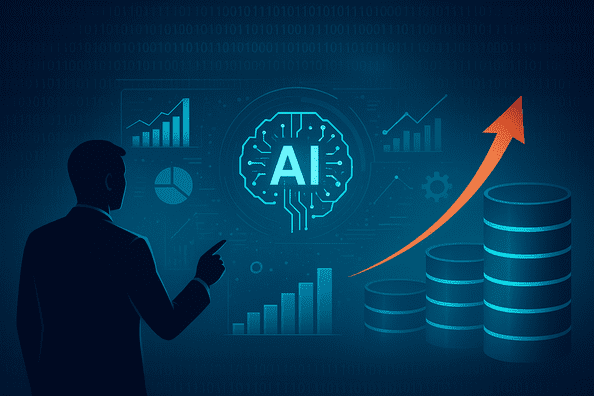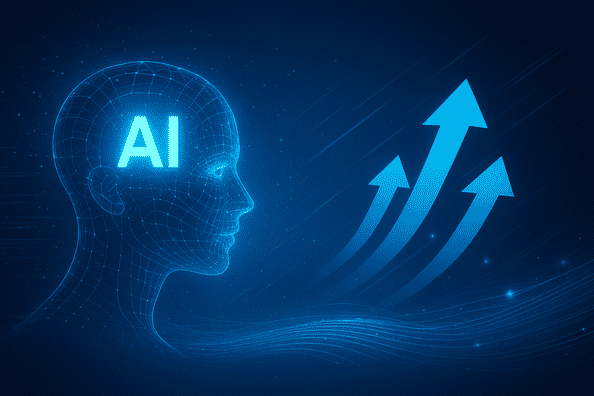Databricks AI has emerged as one of the most remarkable success stories in the modern tech landscape, transforming from a simple Apache Spark platform into a comprehensive data intelligence powerhouse worth over $100 billion. What started as an academic research project at UC Berkeley has evolved into the world’s leading unified analytics platform, serving more than 15,000 organizations globally and fundamentally changing how enterprises approach big data and artificial intelligence.
The story of Databricks AI represents more than just corporate growth – it exemplifies how innovative technology can democratize access to advanced analytics and machine learning capabilities. From its humble beginnings in 2013 to achieving a $4 billion revenue run rate in 2025, Databricks has consistently pushed the boundaries of what’s possible when data engineering, data science, and business intelligence converge on a single platform.
The Genesis of a Data Revolution
The journey began in the hallways of UC Berkeley’s AMPLab, where a team of computer science PhD students recognized a fundamental problem plaguing the industry. While tech giants like Google and Facebook had sophisticated internal platforms for leveraging data and AI, most enterprises were stuck with clunky, siloed systems focused on basic business intelligence.
Ali Ghodsi, who would become Databricks’ CEO, brought a unique perspective to this challenge. Having fled Iran as a child and later moving to Sweden, Ghodsi’s early exposure to programming on a Commodore 64 at age six sparked a lifelong passion for technology. His journey from a curious child reading computer manuals to a visiting scholar at UC Berkeley exemplifies the global nature of innovation that would later define Databricks AI.
The founding team of seven PhD students – Ali Ghodsi, Ion Stoica, Matei Zaharia, Patrick Wendell, Reynold Xin, Andy Konwinski, and Arsalan Tavakoli-Shiraji – shared a contrarian vision. They believed organizations shouldn’t have to choose between data lakes and data warehouses, between batch and streaming processing, or between business intelligence and advanced analytics.
From Apache Spark to Unified Intelligence
Databricks AI built its foundation on Apache Spark, an open-source distributed computing framework that revolutionized big data processing. The team’s initial project set a world record for data sorting speed in 2014, with Zaharia’s work winning the award for the year’s best computer science dissertation. But the founders quickly realized that simply creating great technology wasn’t enough – they needed to make it accessible to every organization.
The platform’s evolution from a managed Spark environment to a comprehensive data intelligence platform demonstrates remarkable strategic vision. Initially, Databricks focused on solving the infrastructure challenges around Apache Spark, allowing organizations to run distributed data processing jobs without complex configurations. This approach attracted early customers who were struggling with the complexity of big data technologies.
However, the real breakthrough came when the team expanded their focus beyond data processing to encompass the entire machine learning lifecycle. The introduction of Delta Lake in 2017 addressed critical data reliability and quality issues that plagued data lakes. This storage layer brought ACID transactions to big data, solving fundamental problems around data consistency and enabling more reliable analytics.
The AI-Powered Transformation
The acquisition of MosaicML for $1.3 billion in 2023 marked a pivotal moment in the Databricks AI journey. This strategic move transformed Databricks from a data processing platform into a comprehensive AI company. MosaicML’s expertise in generative AI, particularly their state-of-the-art MPT large language models, provided Databricks with the technology needed to compete in the rapidly evolving AI landscape.
The integration wasn’t merely about acquiring technology – it represented a philosophical alignment around democratizing AI. MosaicML’s focus on helping organizations build, train, and deploy their own AI models using their proprietary data perfectly complemented Databricks’ mission of making advanced analytics accessible to every enterprise.
Mosaic AI, the result of this integration, now offers a comprehensive suite of AI capabilities including agent development, model serving, vector search, and governance tools. The platform enables organizations to build AI agents grounded in their enterprise data, supporting everything from classical machine learning to the latest generative AI applications.
Real-World Impact Across Industries
The true measure of Databricks AI’s success lies in its real-world applications across diverse industries. In healthcare, organizations have achieved remarkable results – one large healthcare automation company reduced medication errors to zero and boosted efficiency by 83% using Databricks’ automated medication management system.
The financial services sector has seen equally impressive transformations. Block achieved a 12x reduction in computing costs while using Databricks AI to enable GenAI innovations across their platform. Their implementation includes AI-powered business onboarding, automated content generation for marketing, and AI-enhanced product photography for eCommerce sellers.
Manufacturing companies leverage Databricks AI for predictive maintenance, production optimization, and supply chain resilience. By analyzing sensor data and historical maintenance records, manufacturers can predict equipment failures before they occur, significantly reducing downtime and maintenance costs.
The retail and eCommerce sectors have transformed customer experiences through personalization engines powered by Databricks AI. These systems analyze customer behavior, purchase history, and preferences to deliver hyper-personalized recommendations and dynamic pricing strategies that maximize revenue while improving customer satisfaction.
The Billion-Dollar Growth Engine
Databricks AI’s financial trajectory tells a compelling story of sustained growth and market expansion. The company’s revenue evolution demonstrates the increasing demand for unified data and AI platforms:
|
Year |
Revenue Run Rate |
Key Milestones |
|
2023 |
$1.5 billion |
MosaicML acquisition, 50% growth |
|
2024 |
$3.0 billion |
Series J funding at $62B valuation |
| 2025 | $4.0 billion |
Series K funding at $100B+ valuation |
The company’s AI products alone crossed $1 billion in revenue run rate, highlighting the massive market opportunity in artificial intelligence. With over 650 customers spending more than $1 million annually and a net retention rate sustaining above 140%, Databricks demonstrates both customer satisfaction and expansion within existing accounts.
The platform serves an impressive roster of enterprise clients, including Shell, JPMorgan Chase, Rivian, and over 60% of the Fortune 500. This enterprise adoption reflects the platform’s ability to handle mission-critical workloads while providing the governance, security, and compliance features that large organizations require.
Innovation Through Open Source Leadership
Databricks AI has maintained its commitment to open source innovation, contributing significantly to the broader data and AI ecosystem. The company’s recent donation of Spark Declarative Pipelines to Apache Spark demonstrates this ongoing commitment. This framework, used by thousands of Databricks customers, tackles one of data engineering’s biggest challenges by making it easier to build and operate reliable, scalable data pipelines.
The platform’s open architecture ensures organizations aren’t locked into proprietary systems. Support for multiple programming languages including Python, Scala, R, and SQL, combined with integrations across major cloud providers (AWS, Azure, Google Cloud), gives organizations flexibility in their technology choices.
Delta Lake, MLflow, and Unity Catalog – all open source projects originated by Databricks – have become industry standards. This approach of contributing back to the community while building commercial value around these technologies has created a virtuous cycle of innovation and adoption.
The Data Intelligence Platform Revolution
Databricks AI has evolved beyond traditional analytics to introduce the concept of a Data Intelligence Platform – a system that understands the unique semantics of an organization’s data. This intelligent approach combines generative AI with the unification benefits of a lakehouse architecture to automatically optimize performance and manage infrastructure in ways specific to each business.
The platform’s natural language capabilities dramatically simplify the user experience. Data discovery becomes as easy as asking questions in plain English, while AI assistance helps with code generation, error remediation, and finding answers. This democratization of data access means that business users can interact with complex datasets without requiring deep technical expertise.
Databricks IQ represents the next evolution of this intelligence, providing AI-driven analytics that help organizations derive faster insights and optimize decision-making. The system learns from how data is used across the organization, automatically suggesting optimizations and identifying patterns that might not be apparent to human analysts.
Industry-Specific Solutions and Use Cases
Databricks AI has developed specialized solutions for various industries, each addressing unique challenges and requirements. In the financial services sector, the platform powers fraud detection systems that analyze transaction patterns in real-time, preventing losses while minimizing false positives.
Healthcare organizations use Databricks AI for drug discovery, clinical trial optimization, and personalized treatment recommendations. The platform’s ability to process diverse data types – from genomic sequences to medical imaging – makes it particularly valuable for healthcare innovation.
Supply chain optimization represents another crucial application area. Organizations use Databricks AI to predict demand fluctuations, optimize inventory levels, and identify potential disruptions before they impact operations. The platform’s real-time processing capabilities enable dynamic responses to changing market conditions.
In the energy sector, companies leverage Databricks AI for predictive maintenance of critical infrastructure, optimization of energy distribution networks, and integration of renewable energy sources. The platform’s ability to process IoT sensor data at scale makes it ideal for monitoring complex industrial systems.
The Future of Enterprise AI
Looking ahead, Databricks AI is positioning itself for the next wave of enterprise AI adoption. The introduction of Agent Bricks represents a significant step toward autonomous AI systems that can perform complex tasks without human intervention. These AI agents, optimized on enterprise data, can automate operations, generate insights, and even make decisions within defined parameters.
Lakebase, Databricks’ new operational database built on open source Postgres and optimized for AI agents, addresses the growing need for AI systems to access both analytical and operational data. This convergence of traditionally separate data architectures reflects the platform’s vision of unified data intelligence.
The company’s continued investment in AI research and development, supported by its recent $1 billion Series K funding, ensures that it will remain at the forefront of AI innovation. Strategic partnerships, such as the $100 million deal with Anthropic, provide access to cutting-edge AI models while maintaining the flexibility to work with multiple AI providers.
Challenges and Competitive Landscape
Despite its success, Databricks AI operates in an increasingly competitive landscape. Traditional competitors like Snowflake (with a $4.5 billion revenue run rate) continue to innovate, while cloud giants Amazon, Microsoft, and Google offer their own comprehensive data and AI platforms.
The rapid evolution of AI technology presents both opportunities and challenges. While Databricks AI has positioned itself well with its comprehensive platform approach, the emergence of new AI paradigms and models requires continuous innovation and adaptation.
Talent acquisition and retention remain critical challenges in the competitive AI market. Databricks continues to invest heavily in recruiting top AI talent, with funding specifically allocated for this purpose. The company’s academic roots and commitment to open source development help attract researchers and engineers passionate about advancing the field.
Conclusion: From Research to AI Leadership
The Databricks AI journey from a UC Berkeley research project to a $100+ billion valuation represents one of the most successful technology transformations of the past decade. By consistently focusing on democratizing access to advanced analytics and AI capabilities, the company has created a platform that serves the needs of both technical specialists and business users.
The platform’s success demonstrates the power of unified architectures in an increasingly complex data landscape. Rather than forcing organizations to choose between different technologies and approaches, Databricks AI provides a comprehensive solution that grows with organizational needs and technological advances.
As enterprises continue their digital transformation journeys, the demand for platforms like Databricks AI will only increase. The company’s commitment to open source innovation, combined with its comprehensive commercial offerings, positions it well for continued growth and market leadership.
The story of Databricks AI proves that with the right vision, technology, and execution, it’s possible to transform not just how organizations use data, but how they think about the relationship between data and business value. In turning big data into billion-dollar AI innovation, Databricks has created a template for success that will influence the industry for years to come.



